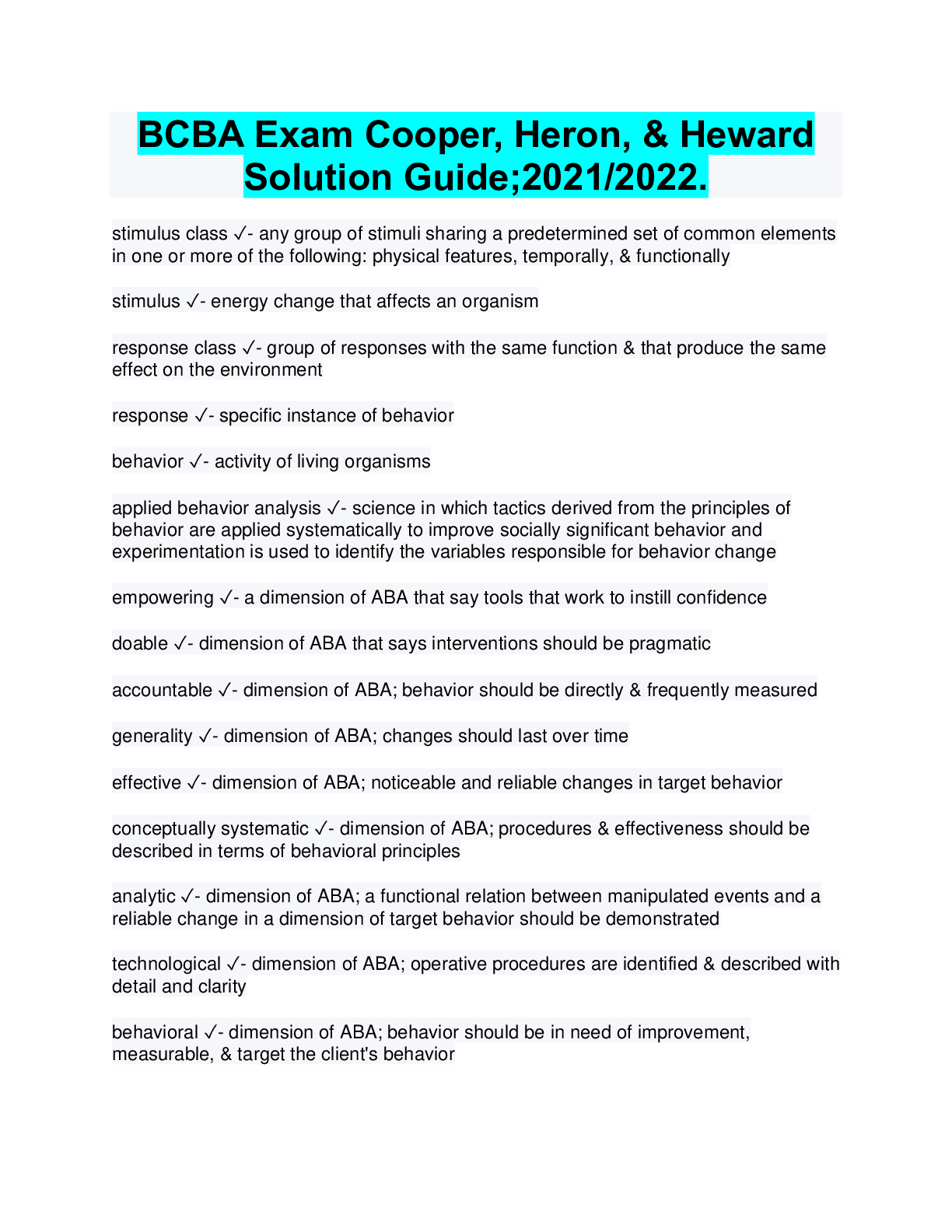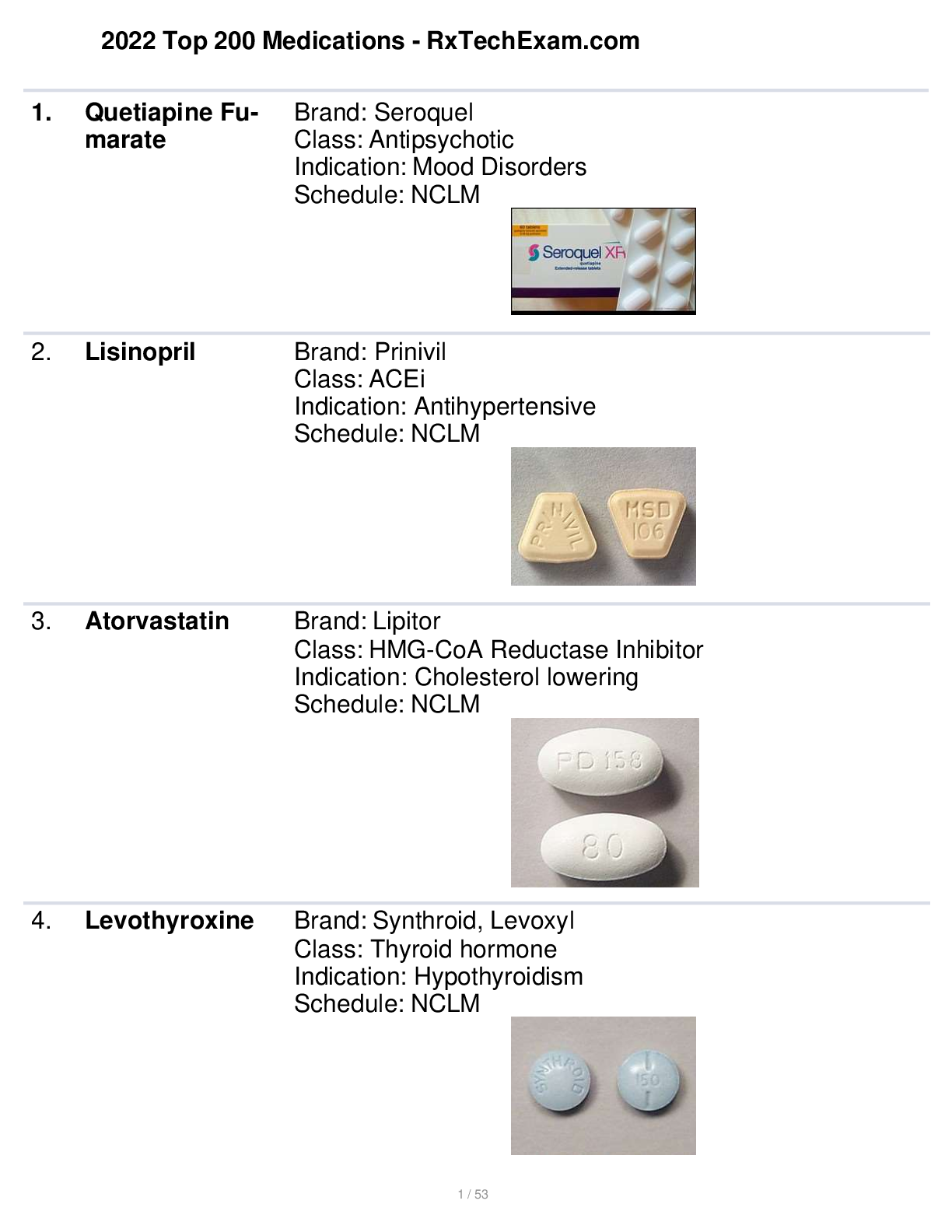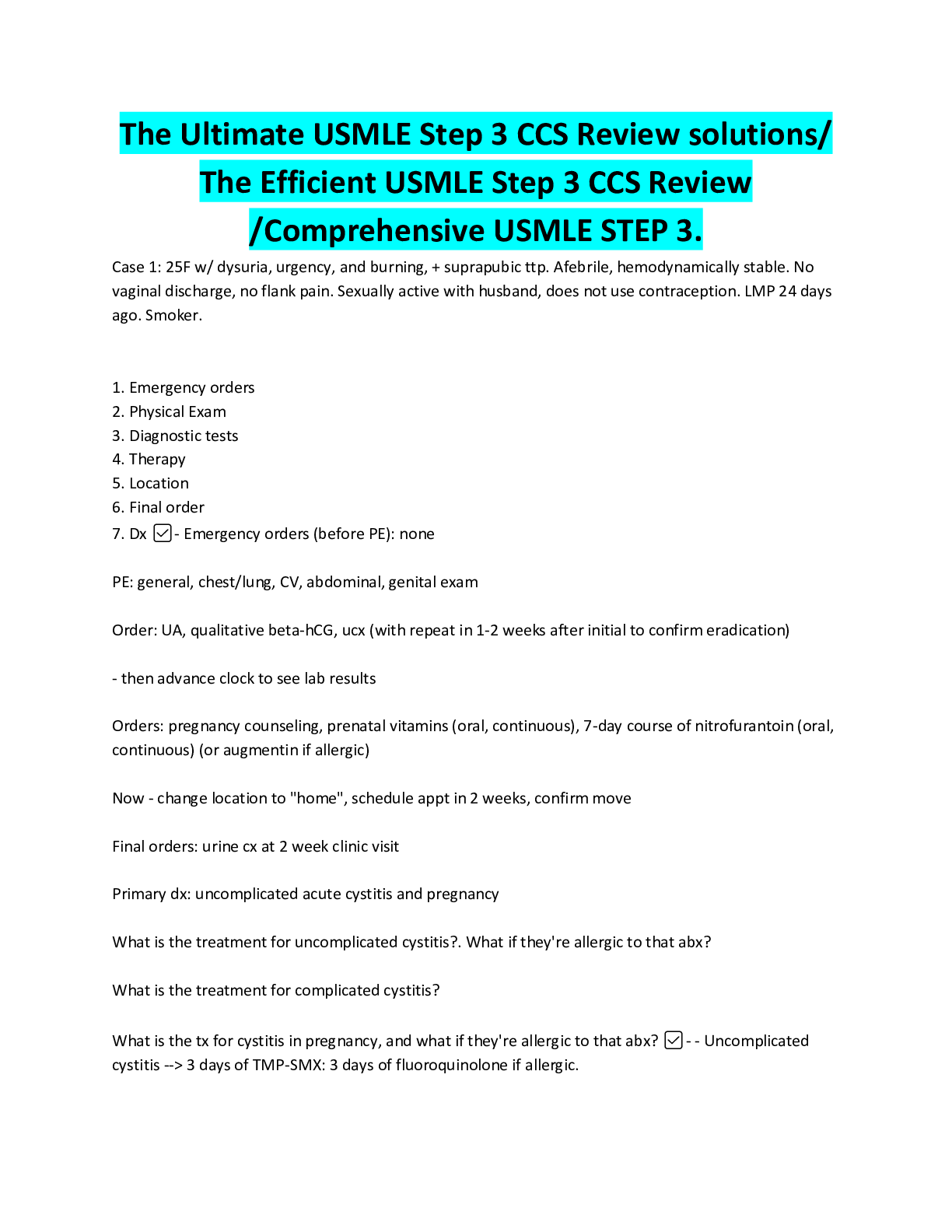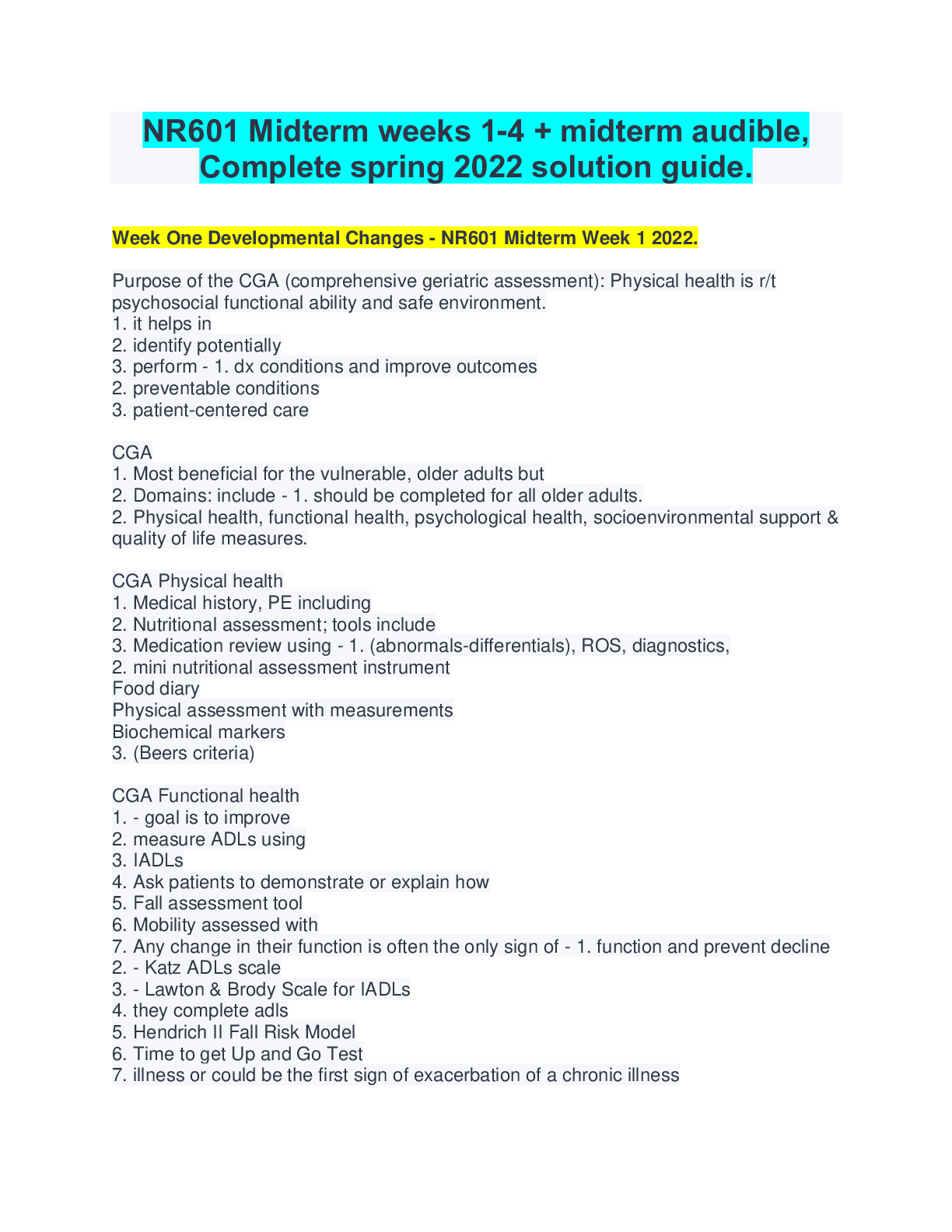Paediatrics > Solutions Guide > (Solution guide) 2022 International Board Certified Lactation Consultant (IBCLC) Certification Exam. (All)
(Solution guide) 2022 International Board Certified Lactation Consultant (IBCLC) Certification Exam.
Document Content and Description Below
(Solution guide) 2022 International Board Certified Lactation Consultant (IBCLC) Certification Exam. Ibclc 2022/ IBCLC Exam A+ Solution Guide Embryo and neonate weeks 3-4 ✓- A primitive milk s... treak running bilaterally from axilla to groin Embryo and neonate Weeks 4-5 ✓- Milk streak becomes mammary milk ridge or milk line . Paired breasts develop from this line of glandular tissue Embryo and neonate weeks 7/8 ✓- Thickening and inward growth into chest wall continue Embryo and neonate weeks 12-16 ✓- Specialized cells differentiate into smooth muscle of nipple and areola - epithelial cells develop into mammary buds - epithelial branches form to eventually become alveoli Embryo and neonate weeks 15-25 ✓- Epithelial strips are formed which represent future secretory alveoli - lactiferous ducts and their branches form and open into a shallow epithelial depression known as the mammary pit - the mammary pit becomes elevated forming the nipple and the areola - an inverted nipple results when the pit fails to elevate Embryo and neonate After 32 weeks ✓- A lumen ( canal ) forms in each part of the branching system Embryo and neonate Near term ✓- 15-25 mammary ducts form the fetal mammary gland Neonate ✓- - galactorrhea ( witch's milk ) : secretion of colostral like fluid neonate mammary tissue resulting from influence of maternal hormones - recommended not to express neonatal colostrum because this might lead to mastitis in the newborn Puberty ✓- 1. Breasts keep pace with general physical growth 2. Growth of the breast parenchyma produces ducts , lobes, alveoli, and surrounding fat pad 3. Onset of menses at 10-12 continues development of the breast - primary and secondary ducts grow and divide . - terminal end buds form , which later become alveoli (small sacs where milk is secreted ) in the mature breast - proliferation and active growth of duct tissue takes place during each period and continues to about 35 years of age Pregnancy breast Development ✓- 1. Complete development of mammary function occurs only in pregnancy 2. Breast size increases , skin appears thinner , and veins become more prominent 3. Areola diameter increases - Montgomery glands enlarge , and nipple pigment darkens Anomalies in breast Development ✓- 1. Illnesses, chemo, therapeutic radiation to the chest , chest surgery , or injuries to the chest might affect development 2. Programmed apoptosis ( cell death ) has been suggested as one reason for lower breast cancer rates in bf women Exterior breast ✓- Located in the superficial fascia ( fibrous tissue beneath skin) between 2nd rib and 6th intercostal space Tail of spence ✓- Mammary glandular tissue that projects into the axillary region - distinguished from the supernumerary tissue because it connects to the duct system - potential are of milk pooling and mastitis Skin surface of Breast contains ✓- Nipple, areola, and Montgomery glands Size ✓- Not related to functional capacity Gives breast it's Shape and size ✓- Fat composition Size may indicate ✓- Milk storage potential Nipple ✓- Conical elevation located slightly below center of areola Average diameter of Nipple ✓- 1.6cm Average length of Nipple ✓- 0.7 cm Hoe many milk Duct openings In nipple ✓- 5-10 Smooth muscle fibers Function as a ✓- Closure mechanism to keep milk from continuously leaking from the nipple The nipple is Densely innervated With ✓- Sensory nerve endings What makes the nipple erect when contracted ✓- Longitudinal inner muscles and outer circular and radial muscles Venostasis ✓- Slows blood flow and decreases surface area Areola ✓- Dark pigmented area that surrounds the nipple - elastic like nipple Average diameter Of areola ✓- 6.4 cm Areola is constructed Of ✓- Smooth muscle and collagenous , elastic , connective tissue fibers in radial and circular arrangement How does the nipple Aid infant in latching ✓- Becomes smaller , firmer, and more prominent What happens to Areola in pregnancy ✓- Darkens and enlarges Where are montgomerys tubercules located ✓- Around the areola The Montgomery tubercules contain ✓- Ductal openings of the sebaceous and lactiferous glands and sweat glands What happens to Montgomery glands in pregnancy ✓- They enlarge and resemble small , raised pimples The Montgomery glands secrete ? ✓- A substance that lubricates and protects the nipple Some secrete a small amount of milk Secretions of the Montgomery gland may produce ? ✓- A scent to help the infant locate the nipple Parenchyma are ✓- Functional parts of the breast Alveoli are ? ✓- ( acini) are the basic components of the mature mammary gland . Secretory cells in which the milk is produced Lactocytes ( specialized epithelial cells ) that line the interior of the alveolus do ? ✓- Absorb nutrients , immunoglobulin, and hormones from the mothers bloodstream to compose milk Prolactin receptor sites in the lactocytes Allow? ✓- Prolactin to be absorbed from the blood and enter into the alveoli to stimulate milk production Myoepithelial cells do what ? ✓- Encase the alveoli and contact in response to oxytocin to eject milk into ductules How many lobes does the breast contain ✓- 15-25 that carry the milk through the ductules from the alveoli to the nipple Each lobe contains how many alveoli ✓- 10-100 in an intricate system of ductules that branch out from the lobes to converge into lactiferous ducts behind the nipple Ultrasound of lobes shows? ✓- Connections between lobes What do ducts do in response to milk ejection ✓- Temporarily widen What do ducts do in response to duct drainage ✓- Narrow What happens to milk that is not removed ✓- It flows backward up the collecting ducts Lactiferous ducts lead to ✓- 5-10 openings in the nipple Stroma ✓- Supporting tissues of the breast Stroma include ✓- Connective tissue , fat tissue, blood vessels , nerves, and lymphatics Coopers ligaments are ✓- Suspensory ligaments running vertically through the breast What do coopers ligaments do ✓- Attach the deep layer of subcutaneous tissue to the dermis layer of the skin The breast is highly ✓- Vascular What supplies 60%of blood to the breast ✓- Internal mammary artery What supplies 30%of blood to the breast ✓- Lateral thoracic artery Blood vessels within the breast do ? ✓- Enlarge What stimulates growth of the ducts ✓- Surges of estrogen What causes glandular tissue to expand ? ✓- Surges of progesterone The lymphatic system collects ? ✓- Excess fluids from tissue spaces, bacteria, and cast off cell parts The lymphatic system drains where ? ✓- The axillary lymph nodes mainly Breast innervation derives from mainly where ? ✓- Branches of the 4th, 5th, and 6th intercostal nerves Where is nerve supply sparse ? ✓- The innermost parts of the breast The fourth intercostal nerve ✓- Penetrates the posterior aspect of the breast The 4th intercostal nerve supplies the greatest amount of sensation to the areola where ? ✓- 4:00 on the left breast and 8:00 on the right breast How many branches does the 4th intercostal nerve divide into ✓- 5 branches and it becomes more superficial as it reaches the areola The Lowermost branch of the 4th intercostal nerve penetrates the areola where ? ✓- 5:00 on left breast and 7:00 on the right Trauma to the 4th intercostal nerve might result in ✓- Some loss of sensation in the breast If the lowermost branch of the 4th intercostal nerve is severed what happens ? ✓- Loss of sensation to the nipple and areola may result Aberrant sensory or autonomic nerve distributions in the nipple/areola complex could ✓- Affect milk ejection reflex and secretion of prolactin and oxytocin Trauma or severing of the 4th intercostal nerve could result from ✓- Breast augmentation or reduction surgery How much does a non pregnant mature breast weigh ✓- 200g How much does a pregnant near term breast Weigh ✓- 400-600g How much does a lactating breast weigh ✓- 600-800g Asymmetry is common . Which breast is often larger ✓- Left larger than right often Hypermastia ✓- Presence of an accessory mammary gland - accessory or supernumerary nipple develops along the milk line between the axilla and groin - often prominent during pregnancy and lactation Hypermastia can be associated with ✓- Renal or other organ system abnormalities What can lactate and undergo malignant changes ✓- Accessory glandular tissue tissue Hyperthelia ✓- Nipple without accompanying mammary tissue Hypertrophy ✓- Abnormally large breast Hypomastia ✓- Abnormally small breast Hyperplasia ✓- Overdevelopment of the breast - hyperplastic breast Hypoplasia ✓- Underdevelopment of the breast - hypoplastic breast Tubular or tuberous shape of because lack of glandular tissue ✓- Hypoplastic breast Breasts may have large areolas ✓- Hypoplastic breasts Breast are frequently asymmetric and widely spaced ✓- Hypoplastic breast What type of breast may present increased risk for insufficient milk ✓- Hypoplastic breast Poland's syndrome ✓- Unilateral hypoplasia of the breast combined with hypoplasia of the thorax and pectoral muscle The normal nipple should ✓- Evert and become protractor when compressed or stimulated What is the range of incidence of poor protractility in primigravid women ✓- 10-35% Protractility ✓- Improves during pregnancy - effect on latch is minimal when baby has a large amount of breast tissue Nipple inversion occurs in how many women ✓- 3% and is usually bilateral A truly inverted nipple does what ✓- Remains inverted when compressed or stimulated A pseudo inverted nipple does what ✓- Appears inverted but everts when compressed or stimulated A short shanked nipple does what ✓- Appears Everted but retracts when compressed or stimulated Common nipple does what ✓- Protrudes slightly when at rest and becomes more erect and graspable when stimulated - baby can find and pull in mouth and stretch it to the roof of his mouth Flat and or short shanked nipple ✓- May be soft or pliable and have the ability to ridge so it molds to infants mouth without a problem . The flat nipple may have a short shank which makes it less easy to ridge and the baby to find and grasp . May benefit from a syringe to increase protractility . Retracted nipple ✓- Most common type of inverted nipple - initially appears graspable - retracts on stimulation making attachment difficult - does respond well to techniques that increase nipple protrusion Inverted nipple ✓- Truly inverted nipple retracted both at rest and when stimulated. Very uncommon and more difficult for baby to grasp . All techniques used to enhance protractility of breast tissue can be used to improve attachment . Even with nipple retraction baby should be able to latch if mother helps form breast in mouth Bulbous ✓- Large nipple that may be difficult for baby to grasp Dimpled nipple ✓- Increases the risk for maceration as the nipple lies enveloped by the areola Midsagittal ✓- The plane vertically dividing the body through the midline into left and right halves Sagittal ✓- Any plane that is parallel to the midsagittal line vertically divided body into right and left portions Coronal ✓- Frontal - any plane dividing body into anterior or posterior Transverse ✓- Upper and lower portions Ipsilateral ✓- Pertaining to the same side Contralateral ✓- Pertaining to the opposite side Alveolus ✓- A small cavity in the breast - an arrangement of lactocytes around a central Lumen drained by a ductule Process ✓- Projections on a bone Fontanel ✓- Junctions of cranial bones covered by a tough membrane Lumen ✓- The cavity or channel within a tube or tubular organ Temporomandibular ✓- Opens and closes the jaw . Lateral displacement of the mandible Suture ✓- A joint that does not move - the bones are united by a thin layer of fibrous tissue Involuntary muscles ✓- Contraction controlled by autonomic nervous system no willful control Voluntary muscles ✓- Movement using willful control , central nervous system Visceral smooth muscles ✓- Found in digestive and respiratory tracts Cardiac / striated muscles ✓- Involuntary striated muscle - allowing coordination of contraction Skeletal / striated muscle ✓- Voluntary , striated ; gross and fine motors movements Lymphatic system ✓- Drains tissue spaces, provides for intercellular waste disposal , and carries absorbed fat in the blood Endocrine system ✓- Chemical regulator of body functions Occipital bone ✓- Forms the back and base of the cranium ; contains the foramen magnum through which the spinal cord passes Frontal bone ✓- Forms the forehead , roof of the nasal cavity , and orbits Parietal bone ✓- Sides and roof of the cranium Temporal bone ✓- Sides and base of the cranium ; houses the middle and inner ear structures Sphenoid ✓- Butterfly shaped bone bridging the other cranial bones internally forming part of the temple floor of the skull ( sella turcica- seat of the pituitary ) nasal septum , posterior walls of orbits Ethmoid bone ✓- Between the nasal bones and sphenoid ; forms parts of the nasal septum ; walls of orbits Nasal bone ✓- Upper bridge of nose Vomer bone ✓- Posterior nasal cavity ; forms a portion of the nasal septum Lacrimal bone ✓- Anterior , medial wall of the orbit Zygomatic arch ✓- Prominence of the cheeks and part of the lateral wall and floor of the orbits Palatine ✓- Posterior cavity between the maxillae and sphenoid Maxilla ✓- Upper jaw Mandible ✓- Lower jaw Hyoid bone ✓- Horseshoe shaped bone suspended from the styloid process of the temporal bone p Choanae ✓- Posterior nasal apertures paired passages from the nasal cavity to the nasopharynx What does bf do to the choanae ✓- Widens it unless tongue tie is present Coronal suture ✓- Line of articulation between the frontal bone and the 2 parietal bones Sagittal suture ✓- Line of articulation between the 2 parietal bones in the midline Lambdoidal ✓- Anterior articulation between the occipital and parietal bones Anterior fontanel ✓- A diamond shaped interval where the frontal angles of the parietal bones meet the 2 separate halves of the frontal bones Posterior fontanel ✓- A triangular interval at the union of the lambdoid and sagittal sutures Sphenoidal fontanel ✓- Irregularly shaped interval on either side of the skull Mastoid fontanel ✓- Interval on either side of the posterior skull Cranial nerve I ✓- Olfactory : smell cranial nerve 2 ✓- Optic : sight Cranial nerve 3 ✓- Oculormotor:innervates external muscles for several movements of the eye Cranial nerve 4 ✓- Trochlear : innervates muscles that move the eye up and down Cranial nerve 5 ✓- Trigeminal : three branches : muscles of mastication Cranial nerve 6 ✓- Abducens: moves the eye away from the center of the body Cranial nerve 7 ✓- Facial : muscles of facial expression Cranial nerve 8 ✓- Vestibulocochlear: hearing and equilibrium Cranial nerve 9 ✓- Glossopharyngeal: taste, sensation in pharynx ( important for swallowing ) Cranial nerve 10 ✓- Vagus: larynx, pharynx Cranial nerve 11 ✓- Spinal accessory : muscles of the neck and shoulder Cranial nerve 12 ✓- Hypoglossal: movements of the tongue How many nerves and muscles must coordinate for swallowing ✓- 26 muscles and 6 cranial nerves Mouth suckling cranial nerves ✓- 5 ( sensory - shape: texture ) 7 motor Tongue suckling cranial nerves ✓- 7, 9 (taste , sensory ) 12 motor Jaw suckling cranial nerves ✓- 5 ( sensory position of TMJ) 5 motor ; 5 does both sensory and motor Palate swallowing nerves ✓- 5, 9 ( sensory ) 5,7,9,10 motor Tongue swallowing nerves ✓- 9 sensory 5,7,12 motor Pharynx swallowing nerves ✓- 5,9 sensory 9, 10 motor Larynx ✓- 10 sensory : 9,10 motor Muscles used in mastication and suckling ✓- Temporalis, Masseter, medial pterygoid , lateral pterygoid, buccinator , orbicularis Oris mentalis Temporalis muscle ✓- Raises the mandible : closes mouth : draws the mandible backward Masseter muscle ✓- Closes the jaw Medial pterygoid muscle ✓- Raises the mandible : closes the mouth Lateral pterygoid ✓- Brings the jaw forward Buccinator ✓- Compresses the cheeks and retracts the angle Orbicularis oris ✓- Closes the lips Mentalis muscle ✓- Elevates center of lower lip Genioglossus muscle ✓- Depressed and extends / protrudes tongue forward Styloglossus muscle ✓- Draws the tongue upward and backward Stylohyoid ✓- Draws the hyoid and tongue upward Digastric muscle ✓- Raises the hyoid or opens the mouth Mylohyoid muscle ✓- Elevated the hyoid : supports the mouth floor Hypoglossus muscle ✓- Depresses the tongue Geniohyoid ✓- Elevates and draws the hyoid forward Superior longitudinal muscle ✓- Elevates tip and sides of tongue , makes tongue concave Inferior longitudinal muscle ✓- Curls tongue tip downward , makes tongue convex Transverse lingual muscle ✓- Narrows, elongages and protrudes Vertical lingual muscle ✓- Broadens and lengthens tongue Sternohyoid muscle ✓- Depresses the hyoid and larynx Omohyoid muscle ✓- Depresses the hyoid Sternothyroid muscle ✓- Depresses the thyroid cartilage Thyrohyoid ✓- Raises and changes the form of the larynx The oral cavity or mouth is bounded by what ✓- The roof , floor, lips , and cheeks The roof of the mouth consists of what ✓- The Palatine process of the maxilla and the palatine bone ( hard palate ) The roof of the mouth transitions into what ✓- Posteriorly into the soft palate and uvula The floor of the mouth consists of what ✓- Mandible spanned by the mylohyoid, geniohyoid , and front of the digastric muscle What muscle surrounds the lips ✓- Orbicularis oris What muscles define the cheeks ✓- Buccinator and Masseter muscles What helps provide stability for the cheek during sucking and provides lateral borders for the tongue ✓- Sucking pads that consist of fatty tissue encased in the cheek The mandible is ✓- Small and retracted The tongue does what ✓- Fills the entire oral cavity and touches the roof and floor of the mouth as well as the lateral gum lines and cheeks Lingual frenulum ✓- Fold of mucous membrane extending from the floor of the mouth to the midline of the under surface of the tongue , should regress during midgestation Labial frenae ✓- The membranes that attach the lips to the gum ridges , inferiorily and superiority Pharynx ✓- A soft muscular tube at the back of the throat Oropharynx ✓- Composed of the area between the elevated soft palate and the epiglottis Nasopharynx ✓- Section of the pharynx between the nasal choanae and the elevated soft palate : the eustachian tubes originate here Hypopharynx ✓- Extends from base of epiglottis to the cricopharyngeal sphincter Larynx ✓- Gateway to the trachea composed of cartilage suspended by muscles ligaments to the hyoid bone and cervical vertebrae The larynx contains what ✓- The epiglottis and the vocal folds or chords What does the epiglottis do during swallowing ✓- Folds down to cover the airway What do the vocal folds or cords do During swallowing ✓- They close to protect the airway Trachea ✓- Tube that bridges into bronchi leading to each lung Esophagus ✓- A thin muscular tube that extends to the stomach and distends as food is propelled through it by peristaltic motion What does the hard palate do ✓- Assists with positioning and stability of the nipple within the mouth What does the soft palate do ✓- Works with the tongue to create the posterior seal of the oral cavity What does the soft palate do during swallowing ✓- It elevates contacting the pharyngeal walls and closing off the nasal cavity directing the bolus toward the hypopharynx The hard palate should be ✓- Intact and smoothly contoured In utero and after birth the shape of the hard palate ✓- Is contoured by the tongue and it's continual pressure as it rests and moves against the palate Submucous clefts of the soft palate ✓- Cannot be directly visualized High palate ✓- The palate or a portion of the palate is very high altering the shallow saucer shape Wide or flat palate ✓- Reduced arch Narrow palate ✓- Reduced horizontal spread of palate Short and longer palates ✓- Shorter or longer than typical 1 inch from the alveolar ridge ( gum ridge ) to the point where the soft palate folds Channel palate ✓- Midline groove usually from the prolonged presence of orotracheal tubes V shaped arch ✓- A high narrow palate that is narrow anteriorly Bony prominences ✓- Uncommon : more common is an Epstein pearl Epstein pearl ✓- Accumulations of epithelial cells also called a retention cyst located at the juncture of the hard and soft palates Sloped palate ✓- Sudden declines in the normal curve Bubble palate ✓- Concavities of the hard palate confined with a rim Cleft palate ✓- A complete opening in the hard or soft palate resulting from the failure of the primary palate and or palatal shelves to meet and fuse during the 7-8 week of gestation Normal mandible placement is ✓- Upper and lower jaw loosely opposed : both gum ridges in direct opposition Recessed jaw ✓- The lower gum ridge is posterior to the upper gum ridge Micrognathia ✓- An excessively small or posteriorly positioned mandible ; internally the tongue is also posteriorly positioned in relation to the oral cavity What does the tongue do ✓- Brings the nipple into the mouth shaping it and stabilizing its position What happens when the posterior tongue and mandible drop ✓- Negative pressure in the mouth causes milk to flow from the nipple What does the wave of compression from front to back with the tongue do ✓- Exerts positive pressure to initiate swallow moving bolus back into pharynx The tongue forms a central groove in order to ✓- Stabilize the teat and channel fluid toward the pharynx The tongue assists in ✓- Forming a bolus to prep for swallow The tongue is ✓- Soft with a rounded tip The tongue is normally where ✓- The bottom of the mouth with a slight central groove and the tip over the lower gum Tongue tip elevation ✓- The tip of the tongue is in opposition to the upper gum ridge or the palate behind the alveolar ridge Humped tongue ✓- tongue is compressed from front to back Bunched tongue ✓- Compressed in a lateral direction Retracted tongue ✓- Held posteriorly in the mouth behind the inferior alveolar ridge Protruded tongue ✓- The tip rests forward well past the lips Tongue tie or ankyloglossia ✓- A short or tight lingual frenulum What does the rooting reflex cause ✓- Touching or stroking the baby's lips or cheek causes a turning of the head toward the stimulus and opens the mouth ( gape response ) Sucking reflex ✓- A light touch of the nipple or a finger to the lips or tongue initiates the complex movements of the suckle Swallowing is elicited by ✓- A bolus of fluid impacting the sensory receptors of the soft palate and back of the mouth : has both reflexive and voluntary properties triggered at the valeculae in newborns Protrusion reflex ✓- Baby's tongue moves down and foresee grasping and drawing the breast into the mouth Gag reflex ✓- Protects the baby from ingesting items that are too large for the esophagus - elicited in the newborn at the mid tongue area Cough reflex ✓- Mechanism that protects the airway from the aspiration of liquids Scanning ✓- Searching the breasts with the cheeks by moving the head from side to side Stepping reflex ✓- Using the stepping reflex to crawl to the breast Hand movement reflex ✓- Predictable hand movement to stimulate move and shape the breast The breasts are capable of full lactation when ✓- From 16 weeks forward What happens early in the first trimester ✓- Mammary epithelial cells proliferate ductal sprouting and branching are initiated and lobular formation occurs First trimester ✓- Ducts proliferate into fatty pad and ductal ends bud into alveoli First trimester ✓- Increases occur in mammary flow , interstitial water , and electrolyte concentrations First trimester ✓- Mammary blood vessels increase their luminal diameters and form new capillaries around the lobules Third trimester ✓- Secretory cells fill with fat droplets and the alveoli are distended with colostrum Mid pregnancy ✓- Mammary cells become competent to secrete milk proteins but are kept in check by high levels of steroids circulating , particularly progesterone Where do most milk products secreted during pregnancy go ? ✓- They find their way back into the plasma via the leaky junctions (spaces between the mammary alveolar cells ) Lactogenesis is driven by the hormones of the ✓- Endocrine control system What accelerates breast growth ✓- Lactogen , prolactin , and human chorionic gonadotropin What is required for mammary growth and epithelial proliferation during pregnancy ✓- A form of estrogen , 17 beta - estradiol What enhances formation of the lobules during pregnancy ✓- Glucocorticoids What does estrogen do during pregnancy ✓- Increases and stimulates ductal sprouting ✅Continues [Show More]
Last updated: 1 year ago
Preview 1 out of 53 pages
Instant download

Buy this document to get the full access instantly
Instant Download Access after purchase
Add to cartInstant download
Reviews( 0 )
Document information
Connected school, study & course
About the document
Uploaded On
Apr 28, 2022
Number of pages
53
Written in
Additional information
This document has been written for:
Uploaded
Apr 28, 2022
Downloads
0
Views
71



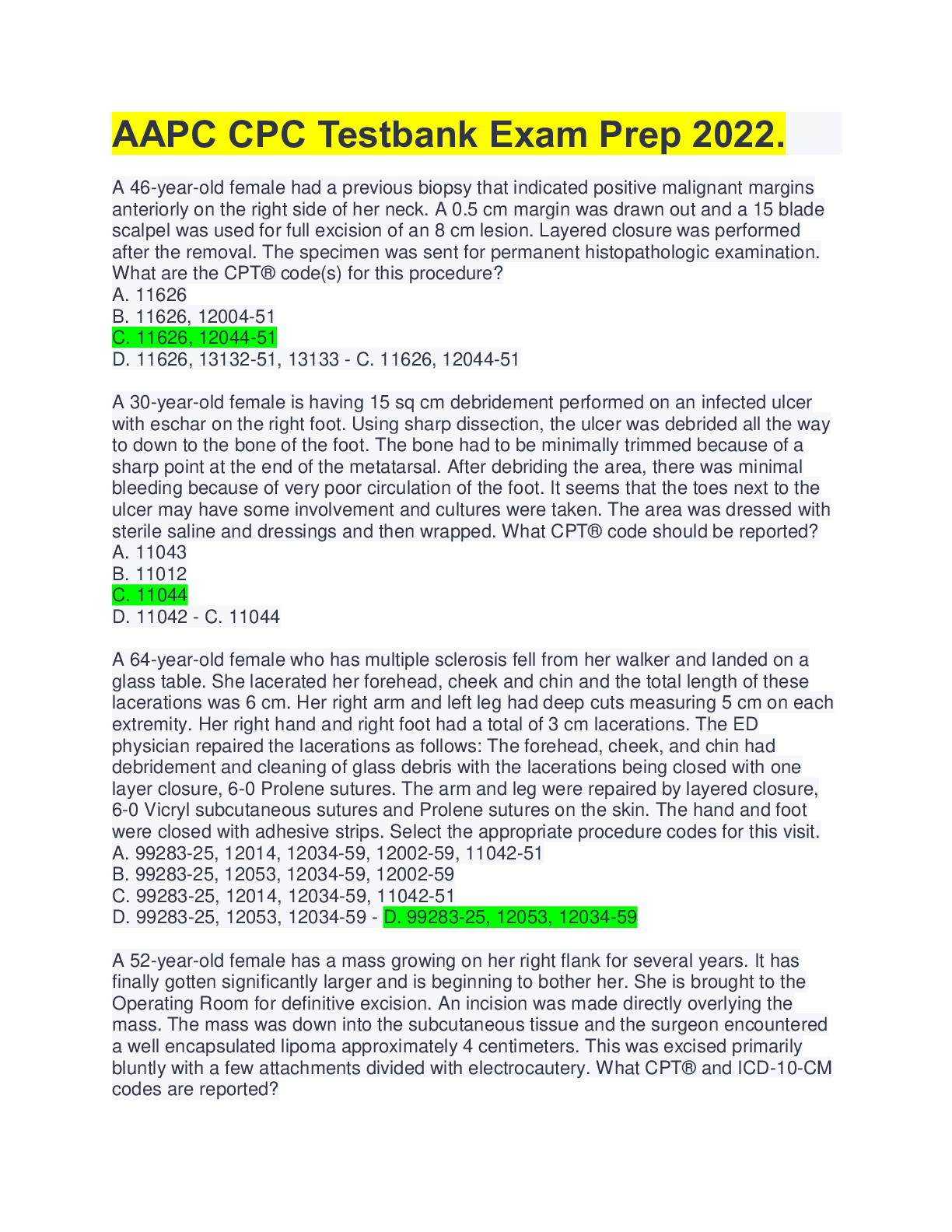
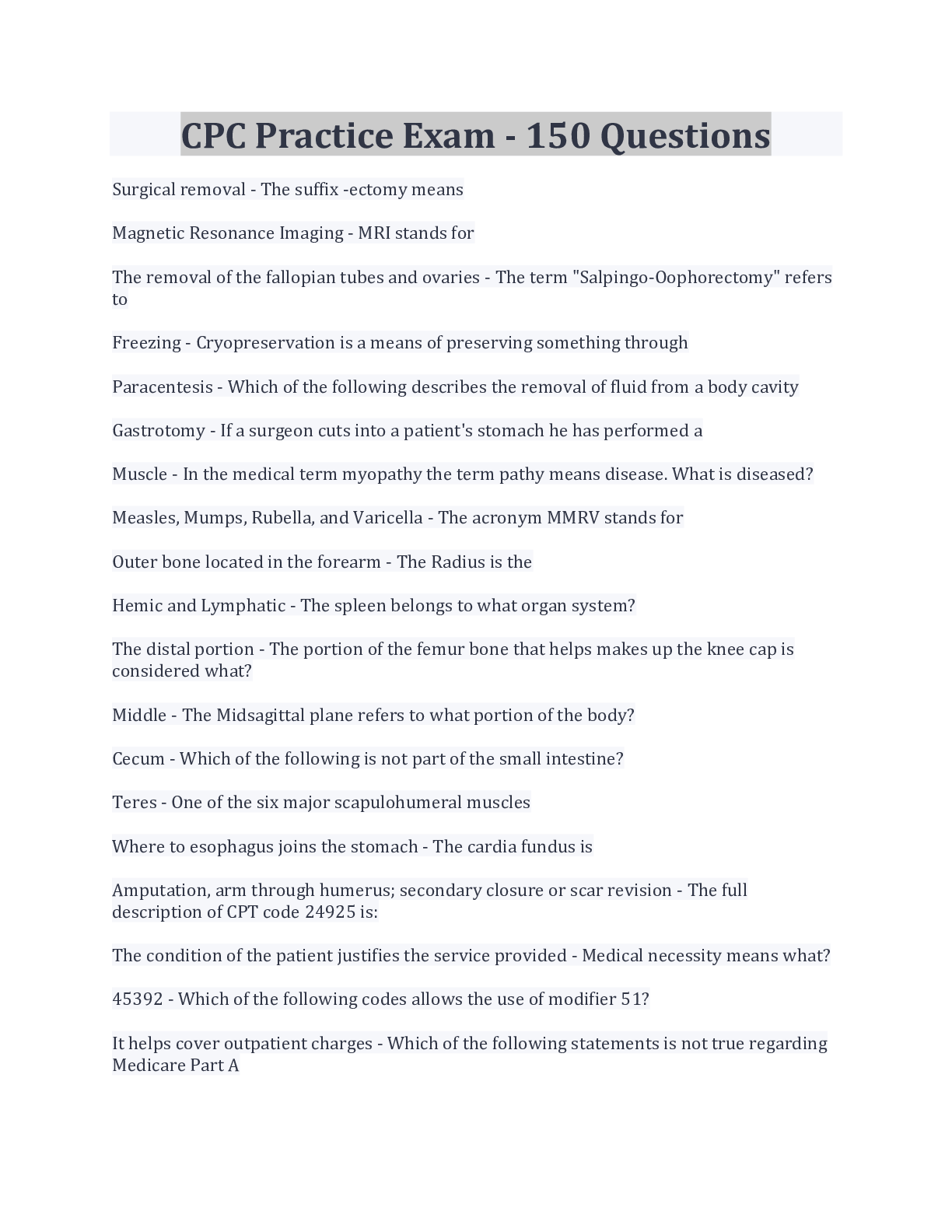
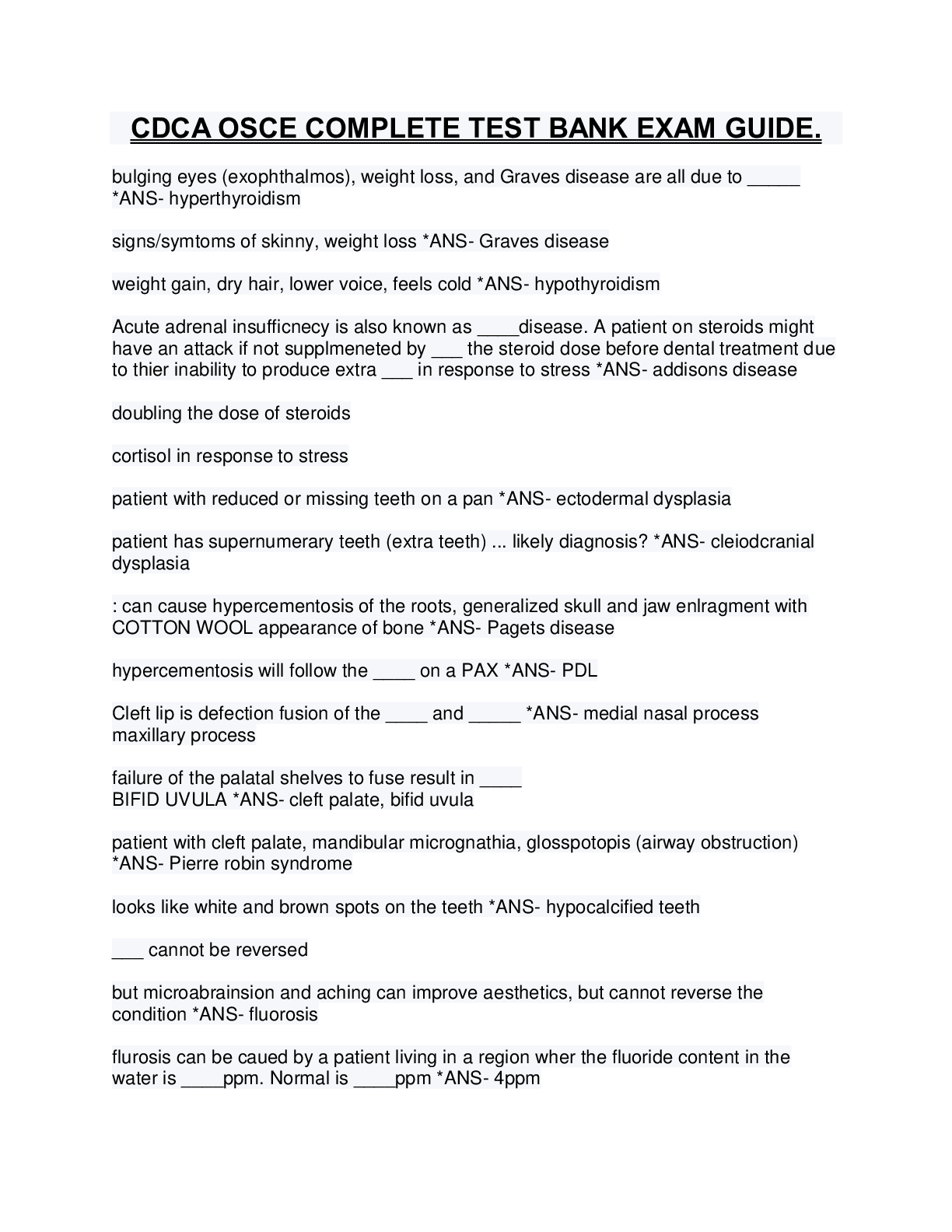
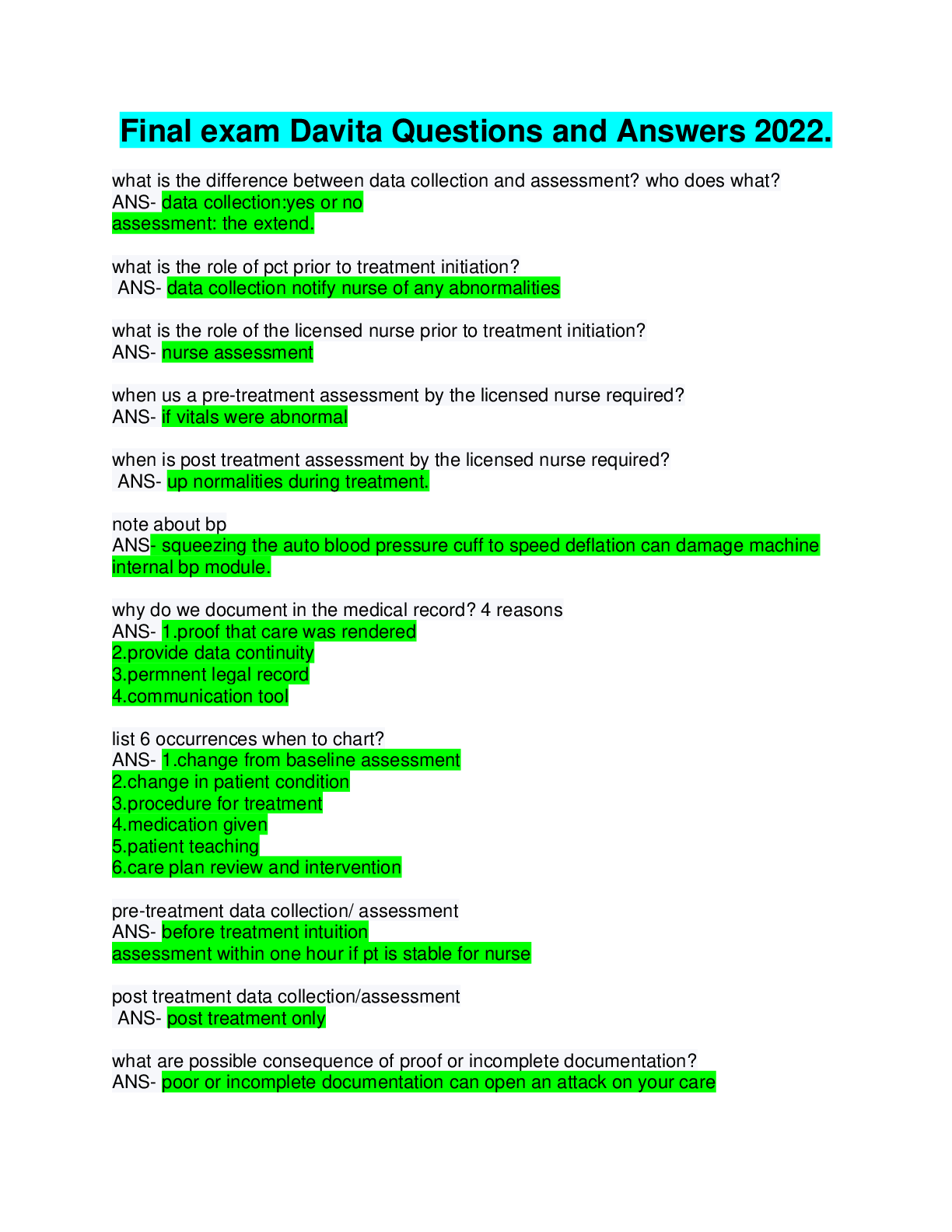
 2022.png)
